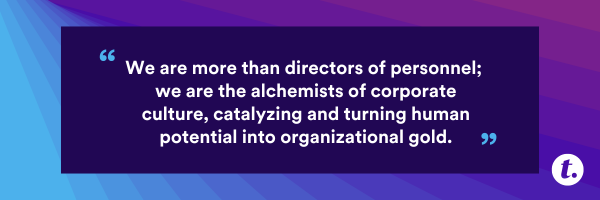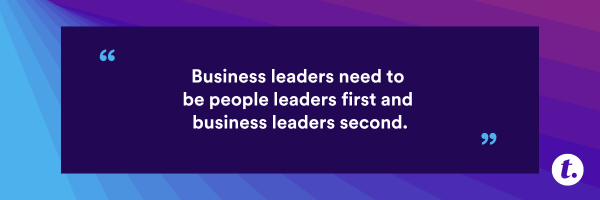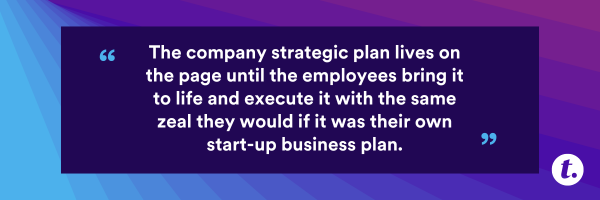
As I struggle to explain my role as a chief people officer to someone outside the HR community, I often lack pithy examples to convey how the modern version of my role differs from the head of personnel back in the 1970s or even the back-office HR department they may currently work with today in their organization. That department sends out nagging payroll or compliance reminders, enforces rules, writes handbooks, and generally has a somewhat intimidating or even irritable disposition.
At my organization, the role of chief people officer has influence because people accord me that influence, not because of the tired exhortation for CHROs to claim our rightful seat at the proverbial leadership table. You don’t ask for status or influence—it is accorded to you through your expertise and capabilities.
If culture truly does eat strategy for breakfast, as Peter Drucker cautioned, we must view culture as the key to solving some of our most vexing corporate challenges. However, it is not just the side of culture where we help foster the connection between people or shape the prosocial signals that employees and managers transmit to each other daily—though that is an endlessly challenging and important piece of the job. I’m arguing for an expansive view of culture to encapsulate myriad business challenges that company culture can address and reinforce. Expanding our view of culture puts the chief people officer squarely in the center of the action. Let me give examples of where the chief people officer needs to expand their presence and influence.

The sum of the decisions we make in our organization—from which products to launch, to where to invest, to whom to hire—is integral to the company’s success. So, realizing that the question then becomes: who decides how we decide? There are a lot of “chief” titles out there, but I haven’t seen a lot of job postings for chief decision-making experts. And so, like so many of these portfolios that fall somewhere between the organization’s silo cracks, I suggest the chief people officer is the one in the best position to help the organization tackle the so-called wicked problem of how to optimize decision-making. After all, we’re the ones who should be guiding hiring managers and our talent acquisition teams around the science of decision-making when it comes to mitigating bias and selecting the right candidates to hire.
As someone who has studied the science of decision-making with an HR lens, in my organization, for example, I was able to champion the idea that the best decisions are made by heterogeneous and psychologically safe groups numbering somewhere between five to eight people. And these same principles show up in all manner of business decision-making and are readily translatable to any decision-making process. Using our expertise and influence here, too, we can move outside the narrow remit of the traditional HR department to benefit the broader organization.
A second area of expansion for the chief people officer is communications. If you’re part of a public corporation or a larger company, you likely have teams of specialized employees who craft external messages for the public or investors. However, communications outside those narrow audiences are deeply linked to culture. The way communication cascades from leaders to all levels of the organization deeply shapes the culture. I find it helpful to think of the collective consciousness of the company as a single organism trying to separate the signal from the noise. Whatever the group decides are the signals, and then they go through a filtering process to decide if it’s in their interests to follow. Author Stan Slap describes this in his book, Under the Hood, “[y]our company culture will notice what you emphasize, what you reward, what you give priority attention to, what you ignore.” When the CEO goes out there and says this is the year of getting down to our core priorities, but the year plays out in the chaotic everything is a priority fire drill cadence as it has in years past, the employee radar detector learns to sit on the sidelines and wait out this latest corporate flash-in-the-pan initiative and doesn’t put its collective heft behind the actual work that needs to get done.
We must design reinforcing processes that signal to employees that our initiatives are not mere lip service but substantive changes worthy of their engagement and trust. This takes what I call coherence in communications, where I view my role as enforcing what Patrick Lencioni often exhorts as the rule of seven—say it seven times before they will believe you. Lencioni also describes the CEO as the chief reminding officer. So, as the one watching to ensure that we’re collectively following the rule of seven, I guess that makes me the minder of the reminder.
The chief people officer’s expertise is in crafting the internal communications messages and designing the reinforcing processes that signal to the employees that this thing we’re talking about is real, we share a future, and it’s in your interests to follow us together on this journey.
When I help shape messages that go out, whether official communications or answers to questions at all-hands meetings posed to the company leadership team, I picture the Greek Chorus typical of plays of ancient Greece and consider how the collective culture will resonate with the message. Will they roll their eyes or get lost in a sea of corporate jargon, or will they climb aboard and decide they want to be part of that future?
My third example of chief people officers taking up the underdeveloped organizational challenges mantle is around strategic planning. I’ve often heard chief people officers are expected to be business leaders first and people leaders second. That sounds nice at first blush, but I’d turn it around a bit. I’d argue that business leaders need to be people leaders first and business leaders second. As executives, we should all be aware by now that the “hard skills” valued in our first years at work have long since been supplanted by our need for exquisitely cultivated soft skills, especially around leadership. And, of course, the soft skills are more complex to cultivate and much more impactful as you begin to lead others. So, it should come as no surprise that the strategic planning process ends up being far less about knowing the details of the business in order to set priorities and much more about the art of setting priorities in the first place.

This, too, loops us back to the arguments for the chief people officer to fill in that gap between the silos that each function operates in and to be the bridge across those teams instead of leveraging the science of how great teams are built and how they optimize decisions. With this expertise and the gravitas the chief people officer has developed around setting priorities and focus, they should find themselves squarely in the strategic planning process.
Beyond the aspects of building the business plan itself, the chief people officer serves as the de facto leader who knows how to harness the collective passion of the employees to deliver and communicate the plan. The company strategic plan lives on the page until the employees bring it to life and execute it with the same zeal they would if it was their own start-up business plan they were pitching to investors, which also links back to the internal communications portfolio previously mentioned.
Expanding and pivoting to fill the gaps should be second nature by now to chief people officers. In recent years, our portfolio has expanded to encompass a host of emerging challenges. We’ve become public health experts for the company; environmental, social, and governance (ESG) leads; workplace futurists; chief purpose officers; and head of employee wellbeing, among other informal roles. More recently, some of us have embraced the role of prognosticators on artificial intelligence and its impact on the future of work. In service of developing expertise and a point of view on these emerging portfolios, I’ve read dozens of long-form medical journal articles on the pathogenesis of SARS-CoV-2 and the correlates of protection offered by mRNA vaccines. I’ve consumed countless books and articles on artificial intelligence to inform my thinking on the future of work. With each of these endeavors, my muse has been my curiosity about navigating the complexity of the world so I can help steward my company through uncertain times with the best evidence and thinking available.
These are complicated problems that require us to be true generalists in the broadest sense of the word and to inhabit all the different domains we can’t expect a CEO to occupy while simultaneously having oversight over marketing, sales, finance, IT, R&D, and the like. It’s no coincidence that the Harvard Business Review increasingly resembles a human resources publication, with each issue invariably being dominated by challenges that fall squarely within our expanding remits as chief people officers. Earlier in my career, I subscribed to several HR journals, but now I find business journals do the same job—often with more rigor and research.

This expansion of purview comes at a cost, of course. The discipline required to delegate core HR functions may prove to be our greatest challenge, particularly for those of us prone to unleashing what author Michael Bungay Stanier calls “The Advice Monster” in his book, The Advice Trap. We may love to share the protean expertise we developed earlier in our career and insert ourselves in specific people matters or play too deep in the benefits and HR compliance space. But that’s a luxury most of us can’t afford. It is precisely this delegation to our talented People teams that allows us to occupy these expanded portfolios. Few, if any, people in your organization have visibility or a position near the CEO or leadership team to successfully occupy this space where the undernourished portfolios of organizational hard problems reside.
As we navigate this evolving organizational landscape, we find ourselves not just at the proverbial leadership table, but often at its head, guiding our organizations through the complex field of organizational performance that ultimately determines corporate success. In this capacity, we are more than directors of personnel; we are the alchemists of corporate culture, catalyzing and turning human potential into organizational gold.

Guest Author: Eric Hunn, Chief People Officer, Premier Protein
Author Bio: Eric Hunn has been leading the People function for Premier Protein & Dymatize, leading brands in protein shakes and protein powders, for the last seven years. He uses the Renaissance Era of amazing social science to explain how to make work great and fuel the evolution of the company culture built on high freedom, high personal development, and deep connection. Their track record of three years of hybrid work with phenomenal, all-time high engagement scores and rankings at the top of workplace lists proves that hybrid can be the sweet spot of high connection some days and high freedom for the rest.
